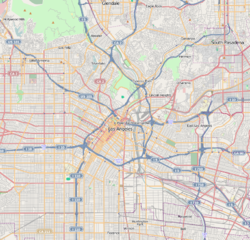Los Angeles Plaza Historic District
|
Los Angeles Plaza Historic District
|
|

La Placita Church
|
|
| Location | Los Angeles, California |
|---|---|
| Coordinates | 34°3′25″N 118°14′16″W / 34.05694°N 118.23778°WCoordinates: 34°3′25″N 118°14′16″W / 34.05694°N 118.23778°W |
| NRHP Reference # | 72000231 |
| LAHCM # | 64 |
| Significant dates | |
| Added to NRHP | November 3, 1972 |
| Designated LAHCM | April 1, 1970 (as 'Plaza Park') |
The El Pueblo de Los Ángeles Historical Monument, also known as Los Angeles Plaza Historic District and formerly known as El Pueblo de Los Ángeles State Historic Park, is a historic district located at the oldest section of Los Angeles, known for many years as "El Pueblo de Nuestra Señora la Reina de los Ángeles del Río de Porciúncula". The district, centered on the old plaza, was the city's center under Spanish (1781–1821), Mexican (1821–1847) and United States (after 1847) rule through most of the 19th century. The 44-acre park area was designated a state historic monument in 1953 and listed on the National Register of Historic Places in 1972.
A plaque across from the Old Plaza commemorates the founding of the city. It states: "On September 4, 1781, eleven families of pobladores (44 persons including children) arrived at this place from the Gulf of California to establish a pueblo which was to become the City of Los Angeles. This colonization ordered by King Carlos III was carried out under the direction of Governor Felipe de Neve." The small town received the name El Pueblo de Nuestra Señora Reina de los Ángeles sobre El Rio Porciúncula, Spanish for The Town of Our Lady Queen of the Angels on the Porciuncula River.
The original pueblo was built to the southeast of the current plaza along the Los Angeles River. In 1815, a flood washed away the original pueblo, and it was rebuilt farther from the river at the location of the current plaza.
During its first 70 years, the Pueblo grew slowly from 44 in 1781 to 1,615 in 1850—an average of about 25 persons per year. During this period, the Plaza Historic District was the Pueblo's commercial and social center. In 1850, shortly after California became part of the United States, Los Angeles was incorporated as a city. It experienced a major boom in the 1880s and 1890s, as its population grew from 11,200 (1880) to 50,400 (1890) and 102,500 in 1900. As the City grew, the commercial and cultural center began to move south away from the Plaza, along Spring Street and Main Street. In 1891, the Los Angeles Times reported on the move of the city's center:
"The geographical center of Los Angeles is the old plaza, but that has long since ceased to be the center of population. ... While at one time most of the population was north of the plaza, during the past ten years 90 per cent of the improvements have gone up in the southern half of the city. ... These are solid facts which it is useless to attempt to ignore by playing the ostrich acts and level-headed property holders in the northern part of the city are beginning to ask themselves seriously what is to be done to arrest or at least delay the steady march of the business section from the old to the new plaza on Sixth Street ..."
...
Wikipedia

